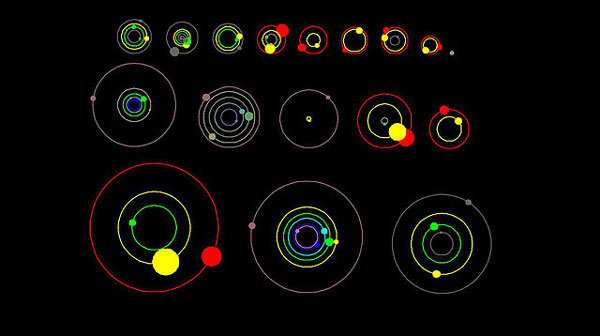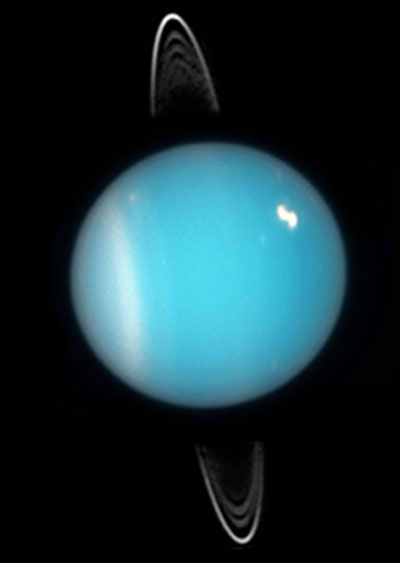Scientists think a significant fraction of exoplanets may be rolling on their sides. If they were, it would explain a longstanding mystery.
Two scientists have suggested that a lot of exoplanets out there are permanently toppled over.
Sarah Millholland and Gregory Laughlin (both at Yale University) propose the scenario March 4th in Nature Astronomy. The idea, weird as it sounds, would solve a longstanding mystery discovered by NASA’s exoplanet-hunting Kepler satellite.

NASA
Dissonance: An Orbital Riddle
Planets come together out of the gas-and-dust disk that surrounds their parent star, and their orbits are constantly changing as they interact with each other and with the disk. For close-together planets, the most stable orbits available to them are resonant, with one planet’s orbital period a multiple of the other’s. For example, the farther-out planet might circle its star twice every time the other, closer-in planet goes around three times. (The result, if put to music, sounds lovely.)
“If you imagine an abstract energy landscape of all possible planetary configurations, resonant ones would represent deep valleys,” explains Daniel Tamayo (Princeton University), who was not involved in the study. “If you sought out the dynamicist in the ivory tower, she would tell you that because of these interactions with the gas disk, you should always find planetary systems in these valleys, in resonant configurations.”
But what Kepler found was that some planets don’t fall in those resonant arrangements. The satellite discovered tens of compact multiple-planet systems, where the planets are on tight orbits that take them around their parent star in less than 100 days, and a surprisingly large fraction of these pairs tend to lie just outside of resonance. For example, the closer planet might complete 3.2 orbits every time the outer planet goes around twice.
“This is very strange,” Tamayo says. “Why just wide of resonance? Why not inside?”
The answer must be that something is pushing these planets out of resonance, but pushing planets around is hard work. Astronomers had previously suggested that the planets themselves might be to blame for their own dissonance, but how remained unclear. Now, Millholland and Laughlin show how that might work: by tilting the exoplanets — and keeping them tilted.
How to Tilt an Exoplanet

NASA / ESA / M. Showalter
If a planet is tilted, its host star will pull on it in a way that re-aligns it over time. The Moon and Earth aligned in a similar way soon after they both formed. Earth’s tidal pull brought up a bulge on the Moon’s equator. The bulge felt Earth’s gravity more strongly than the rest of the Moon’s bulk, and gradually the pull slowed the Moon’s spin and aligned it to Earth’s. In the process, some of the Moon’s rotational energy transferred to its orbit, making it circle Earth from farther away. Even now, as a result of the ocean tides that the Moon raises on Earth, the Moon is slowly (very slowly!) receding from Earth.
The same process would happen for tilted planets; they would slowly move outward as the star’s tidal pull righted the tilt. But remember, planets are hard to move. To be pushed out of resonance with their siblings, planets would need to stay tilted, so that even as the star keeps pulling on the planet, it never pulls the planet upright.
Millholland and Laughlin propose that the planets’ spins precess like wobbling tops. (This is common: Earth’s spin precesses, too, which is why Polaris hasn’t always been our North Star.) Meanwhile, the planets’ orbital planes may also wobble as the planets migrate within the disk. If the frequencies of precession and the orbital-plane wobble line up in just the right way, Millholland and Laughlin find that the two effects combine to tilt the planet and keep it tilted plenty long enough for the star’s tidal pull to push the planets out of resonance.
“If this hypothesis is true, it seems to be a beautiful cosmic coincidence,” Tamayo says. After all, the precession of a planet’s spin and the wobbling of its orbit have nothing to do with each other, so there’s no reason their frequencies should align.
Yet while the prediction may be strange, it’s testable: If these planets are strongly tilted, we should see it in how their infrared brightness changes as they circle their star. In the most extreme case, where a planet is tilted completely on its side like Uranus is, day and night would each be half a year long. Spitzer or the upcoming James Webb Space Telescope could discern the expected patterns in the infrared light curves.
“I think it's a fantastic idea,” Tamayo says. Permanently tilted exoplanets solve the dilemma of how to dissipate enough orbital energy to effectively shove the planets out of resonance. “This would indeed mean that most planets in multiplanet compact systems are toppled over.”
What this scenario means for exoplanets overall remains unclear, Millholland says. “I think it's safe to say that our work suggests that large [tilts] should be common, but further work is required to figure out just how common.”
 5
5
Comments
David Dunn
March 5, 2019 at 5:11 pm
Very Interesting!
However, I believe that the sentence in 3rd paragraph,
For example, the farther-out planet might circle its star three times every time the other, closer-in planet goes around twice.
Should read:
For example, the farther-out planet might circle its star TWO times every time the other, closer-in planet goes around THREE TIMES.
since an inner planet has an shorter orbital period than an outer planet.
You must be logged in to post a comment.
Monica YoungPost Author
March 6, 2019 at 10:22 am
Hi David, you're of course right, the inner planet would be traveling faster - it's the law! (Kepler's 3rd, to be exact.) I've fixed this in the text.
You must be logged in to post a comment.
Peter Wilson
March 5, 2019 at 9:19 pm
If tilted exoplanets explain the odd orbits, being near the galaxy's bar might explain the tipsy planets...
You must be logged in to post a comment.
Rod
March 7, 2019 at 7:55 am
When I read exoplanet reports like this, I wonder how did Earth avoid forming like this? It seems Earth is precariously balanced, some slight change in a myriad of variables (giant impact for example) during its evolutionary formation - we are lifeless here.
You must be logged in to post a comment.
bwana
March 8, 2019 at 7:43 pm
Hmmm... "rolling on their sides"? Rather hard to imagine up/down/sides in three dimensional space! bwa
You must be logged in to post a comment.
You must be logged in to post a comment.